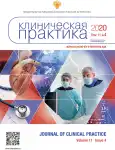Delayed sinus rhythm restoration after thoracoscopic left atrium fragmentation (а report of two cases)
- Authors: Vachev S.A.1, Korolev S.V.1, Zotov A.S.1, Khabazov R.I.1, Troitskiy A.V.1
-
Affiliations:
- Federal Research and Clinical Center of Specialized Medical Care and Medical Technologies FMBA of Russia
- Issue: Vol 11, No 4 (2020)
- Pages: 90-95
- Section: Case reports
- URL: https://journals.rcsi.science/clinpractice/article/view/59550
- DOI: https://doi.org/10.17816/clinpract59550
- ID: 59550
Cite item
Full Text
Abstract
The article presents two clinical cases of delayed restoration of the sinus rhythm in patients with long-term persistent atrial fibrillation after the procedure of thoracoscopic radiofrequency fragmentation of the left atrium. The necessity of continuing attempts to restore the sinus rhythm up to the end of the "blind period" (90 days) is discussed.
Full Text
##article.viewOnOriginalSite##About the authors
Sergey A. Vachev
Federal Research and Clinical Center of Specialized Medical Care and Medical Technologies FMBA of Russia
Author for correspondence.
Email: s.a.vachev@mail.ru
ORCID iD: 0000-0002-2747-3057
SPIN-code: 4940-0634
MD, PhD
Russian Federation, MoscowSergey V. Korolev
Federal Research and Clinical Center of Specialized Medical Care and Medical Technologies FMBA of Russia
Email: sergejkorolev@yandex.ru
ORCID iD: 0000-0001-5513-2332
SPIN-code: 4545-3450
MD, PhD
Russian Federation, MoscowAlexandr S. Zotov
Federal Research and Clinical Center of Specialized Medical Care and Medical Technologies FMBA of Russia
Email: zotov.alex.az@gmail.com
ORCID iD: 0000-0003-0494-0211
SPIN-code: 9315-6570
MD, PhD
Russian Federation, MoscowRobert I. Khabazov
Federal Research and Clinical Center of Specialized Medical Care and Medical Technologies FMBA of Russia
Email: khabazov119@gmail.com
ORCID iD: 0000-0001-6801-6568
SPIN-code: 8264-7791
MD, PhD
Russian Federation, MoscowAlexander V. Troitskiy
Federal Research and Clinical Center of Specialized Medical Care and Medical Technologies FMBA of Russia
Email: dr.troitskiy@gmail.com
ORCID iD: 0000-0003-2143-8696
SPIN-code: 2670-6662
MD, PhD
Russian Federation, MoscowReferences
- Liang J, Dixit S, Santangeli P. Mechanisms and clinical significance of early recurrences of atrial arrhythmias after catheter ablation for atrial fibrillation. World J Cardiol. 2016;8(11):638–646. doi: 10.4330/wjc.v8.i11.638.
- Sanders P, Morton JB, Deen VR, et al. Immediate and long-term results of radiofrequency ablation of pulmonary vein ectopy for cure of paroxysmal atrial fibrillation using a focal approach. Intern Med J. 2002;32(5-6):202–207. doi: 10.1046/j.1445-5994.2002.00215.x.
- Koyama T, Sekiguchi Y, Tada H, et al. Comparison of characteristics and significance of immediate versus early versus no recurrence of atrial fibrillation after catheter ablation. Am J Cardiol. 2009;103(9):1249–1254. doi: 10.1016/j.amjcard.2009.01.010.
- Rostock T, Steven D, Hoffmann B, et al. Chronic atrial fibrillation is a biatrial arrhythmia: data from catheter ablation of chronic atrial fibrillation aiming arrhythmia termination using a sequential ablation approach. Circ Arrhythm Electrophysiol. 2008;1(5):344–353. doi: 10.1161/CIRCEP.108.772392.
- Salzberg SP, van Boven WJ, Wyss C, et al. “AF HeartTeam” guided indication for stand-alone thoracoscopic left atrial ablation and left atrial appendage closure. J Atr Fibrillation. 2019;11(5):2039. doi: 10.4022/jafib.2039.
- Johnkoski J, Miles B, Sudbury A, et al. Safety and long-term efficacy of thoracoscopic Epicardial ablation in patients with paroxysmal atrial fibrillation: a retrospective study. J Cardiothorac Surg. 2019;14(1):188. doi: 10.1186/s13019-019-1018-4.
- Вачев С.А., Богачев-Прокофьев А.В., Зотов А.С., и др. Хирургическое лечение фибрилляции предсердий: технология выполнения торакоскопической радиочастотной фрагментации левого предсердия // Ангиология и сосудистая хирургия. — 2019. — Т.25. — №4. — С. 146–157. [Vachev SA, Bogachev-Prokofiev AV, Zotov AS, et al. Surgical treatment of atrial fibrillation: technique of thoracoscopic radiofrequency fragmentation of the left atrium. Angiologiia i Sosudistaia Khirurgiia. 2019;25(4):146–157. (In Russ).] doi: 10.33529/angio2019416.
- Calkins H, Hindricks G, Cappato R, et al. 2017 HRS/EHRA/ECAS/APHRS/SOLAECE expert consensus statement on catheter and surgical ablation of atrial fibrillation. Heart Rhythm. 2017;14(10):e275–e444. doi: 10.1016/j.hrthm.2017.05.012.
- Jefairi NA, Camaioni C, Sridi S, et al. Relationship between atrial scar on cardiac magnetic resonance and pulmonary vein reconnection after catheter ablation for paroxysmal atrial fibrillation. J Cardiovasc Electrophysiol. 2019;30(5):727–740. doi: 10.1111/jce.13908.
- Honarbakhsh S, Schilling RJ, Orini M, et al. Left atrial scarring and conduction velocity dynamics: Rate dependent conduction slowing predicts sites of localized reentrant atrial tachycardias. Int J Cardiol. 2019;278:114–119. doi: 10.1016/j.ijcard.2018.10.072.
- Methachittiphan N, Akoum N, Gopinathannair R, et al. Dynamic voltage threshold adjusted substrate modification technique for complex atypical atrial flutters with varying circuits. Pacing Clin Electrophysiol. 2020;43(11):1273–1280. doi: 10.1111/pace.14068.
- Haines DE. Biophysics and pathophysiology of lesion formation by transcatheter radiofrequency ablation catheter ablation of cardiac arrhythmias: basic concepts and clinical applications, third edition. New York: WB Saunders; 2006. Р. 20–34. doi: 10.1002/9780470696279.ch2.
- Tanno K, Kobayashi Y, Kurano K, et al. Histopathology of canine hearts subjected to catheter ablation using radiofrequency energy. Jpn Circ J. 1994;58(2):123–135. doi: 10.1253/jcj.58.123.
Supplementary files








